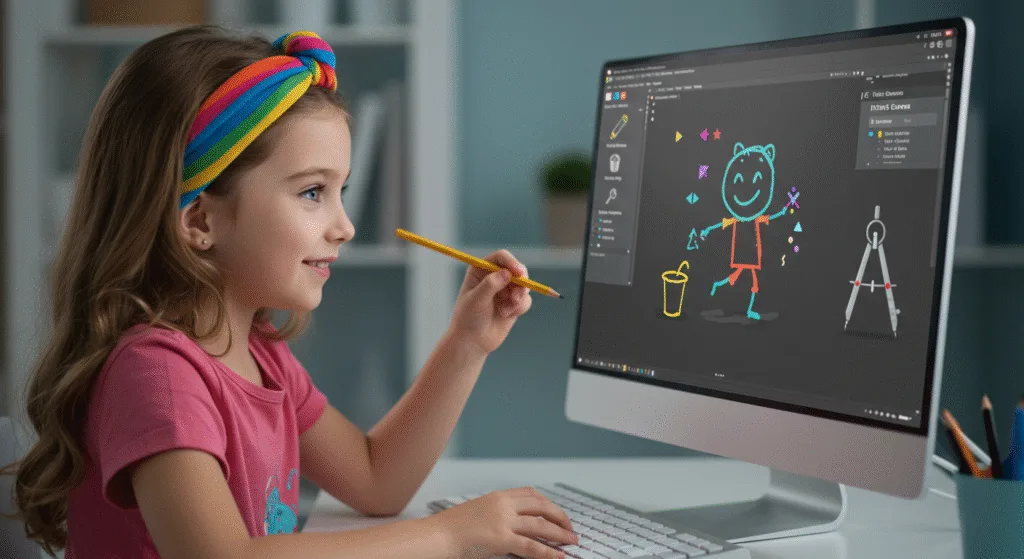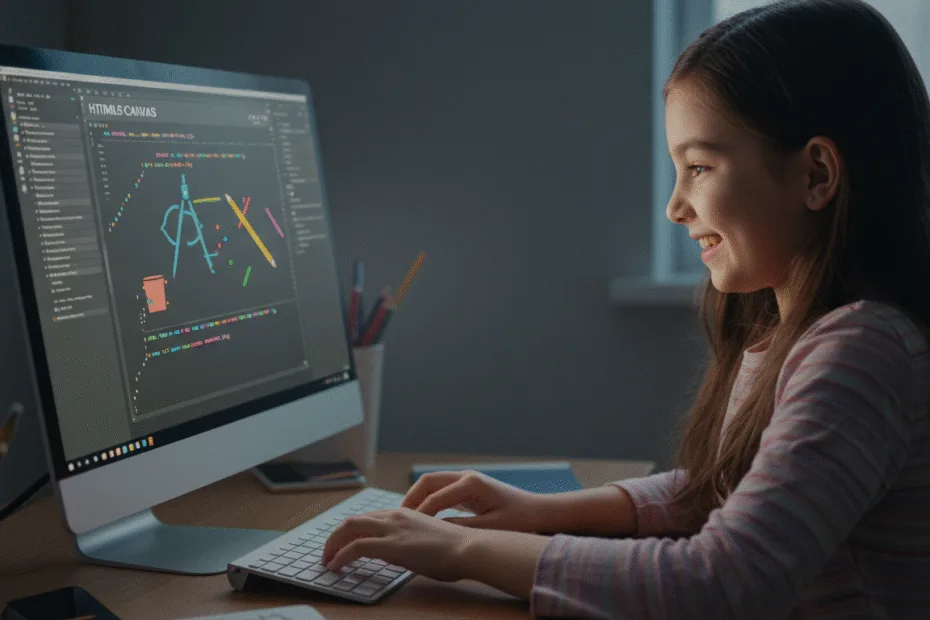Let’s begin with Lecture 40 of the HTML5 & CSS3 series. Introduction to HTML5 Canvas API – Drawing with JavaScript. This lecture is for absolute beginners; even kids can follow along and understand.
🎯 Objective:
By the end of this lecture, you will:
- Understand what the Canvas API is and how it works
- Be able to draw basic shapes like lines, rectangles, and circles
- Learn how to use colors, strokes, and fills
- Create a simple drawing or animation using JavaScript
- Make your website interactive and visual — not just text and buttons!
🎨 What Is the Canvas API?
The Canvas API lets you draw graphics directly in your browser using JavaScript.
Think of it like this:
If your webpage was a canvas for painting, then HTML5 Canvas is your digital art board — and JavaScript is your brush!
You can use it for:
- Games
- Charts and graphs
- Simple animations
- Interactive drawings
- Visual effects
📐 How to Use the <canvas> Element
First, add the <canvas> tag to your HTML:
<canvas id="myCanvas" width="500" height="300"></canvas>Then get access to it using JavaScript:
let canvas = document.getElementById("myCanvas");
let ctx = canvas.getContext("2d"); // 2D drawing contextNow ctx is your paintbrush — time to draw!
🔧 Basic Canvas Methods
| METHOD | DESCRIPTION |
|---|---|
ctx.fillStyle | Sets the color used to fill shapes |
ctx.strokeStyle | Sets the color used for borders |
ctx.fillRect(x, y, width, height) | Draws a filled rectangle |
ctx.strokeRect(x, y, width, height) | Draws an outlined rectangle |
ctx.beginPath() | Starts a new path |
ctx.moveTo(x, y) | Moves the drawing cursor |
ctx.lineTo(x, y) | Draws a line from current point |
ctx.arc(x, y, radius, startAngle, endAngle) | Draws a circle or arc |
ctx.fill() | Fills the current path |
ctx.stroke() | Outlines the current path |
💻 Try This: Draw a Smiling Face on the Canvas
Let’s create a simple drawing of a smiling face using the Canvas API.
Step 1: Create a New File
In your VS Code project folder (MyFirstWebsite), create a new file named:
canvas-drawing.htmlStep 2: Add This Code
<!DOCTYPE html>
<html lang="en">
<head>
<meta charset="UTF-8">
<title>Canvas Drawing</title>
<style>
body {
font-family: Arial, sans-serif;
padding: 40px;
text-align: center;
}
canvas {
border: 1px solid #ccc;
background-color: #fff;
}
</style>
</head>
<body>
<h2>Smiling Face with Canvas</h2>
<canvas id="myCanvas" width="300" height="300"></canvas>
<p style="margin-top: 20px;">
<a href="index.html">Back to Home</a>
</p>
<script>
let canvas = document.getElementById("myCanvas");
let ctx = canvas.getContext("2d");
// Draw face
ctx.beginPath();
ctx.arc(150, 150, 80, 0, Math.PI * 2); // Full circle
ctx.fillStyle = "#ffeb3b"; // Yellow
ctx.fill();
ctx.strokeStyle = "#333";
ctx.stroke();
// Left eye
ctx.beginPath();
ctx.arc(110, 120, 10, 0, Math.PI * 2);
ctx.fillStyle = "black";
ctx.fill();
// Right eye
ctx.beginPath();
ctx.arc(190, 120, 10, 0, Math.PI * 2);
ctx.fill();
// Smile
ctx.beginPath();
ctx.arc(150, 150, 50, 0, Math.PI); // Half-circle
ctx.lineWidth = 3;
ctx.strokeStyle = "black";
ctx.stroke();
</script>
</body>
</html>Step 3: Run with Live Server
Right-click the code → Show All Commands → Launch Live Server
🎉 You’ve drawn a smiling face using only HTML and JavaScript! It’s your first step into the world of web-based graphics.

💡 Bonus: Draw a Rainbow Line
Let’s make a colorful rainbow line across the canvas.
Add This Below Your Smile Code:
// Rainbow Line
ctx.beginPath();
ctx.moveTo(10, 250);
let colors = ["red", "orange", "yellow", "green", "blue", "indigo", "violet"];
for (let i = 0; i < colors.length; i++) {
ctx.strokeStyle = colors[i];
ctx.lineWidth = 10;
ctx.lineTo(60 + i * 50, 250);
ctx.stroke();
ctx.beginPath();
ctx.moveTo(60 + i * 50, 250);
}This draws a rainbow-colored line — one color at a time!
💡 Bonus: Animate a Bouncing Ball
Let’s bring your canvas to life with a bouncing ball animation .
Update Your Canvas Size:
<canvas id="myCanvas" width="500" height="300"></canvas>Replace Your Script with This:
<script>
let canvas = document.getElementById("myCanvas");
let ctx = canvas.getContext("2d");
let x = 100;
let y = 100;
let dx = 3;
let dy = 2;
let radius = 20;
function drawBall() {
ctx.beginPath();
ctx.arc(x, y, radius, 0, Math.PI * 2);
ctx.fillStyle = "#e74c3c";
ctx.fill();
ctx.closePath();
}
function animate() {
ctx.clearRect(0, 0, canvas.width, canvas.height);
// Move ball
x += dx;
y += dy;
// Bounce off walls
if (x + radius > canvas.width || x - radius < 0) {
dx = -dx;
}
if (y + radius > canvas.height || y - radius < 0) {
dy = -dy;
}
drawBall();
requestAnimationFrame(animate);
}
animate(); // Start animation
</script>🎉 Now there’s a red ball bouncing around your canvas — your first animated graphic!
🧪 Try It Yourself!
- Draw a house using rectangles and triangles.
- Create a color picker input that changes the ball color live.
- Add a click event that draws a dot where you click.
- Build a simple game like “Click the Ball” or “Catch the Falling Shapes”.
✅ Summary of What You Learned Today
| CONCEPT | DESCRIPTION |
|---|---|
| Canvas Tag | The area where you draw graphics |
Context (ctx) | Your drawing tool inside the canvas |
| Drawing Shapes | Rectangles, arcs, lines, and paths |
| Colors & Styles | fillStyle,strokeStyle,lineWidth |
| Animation Loop | UserequestAnimationFrame()for smooth animation |
| Event Interaction | Draw based on user clicks or mouse movement |
🚀 Next Lecture Preview:
In Lecture 41 , we’ll explore more advanced Canvas features — including gradients, images, and basic games — so you can build even cooler visuals and interactive experiences!
Stay Updated
If you found this information useful, don’t forget to bookmark this page and Share.
HTML5 and CSS3 Compleate Series
